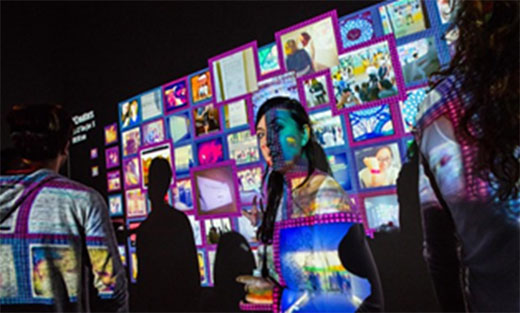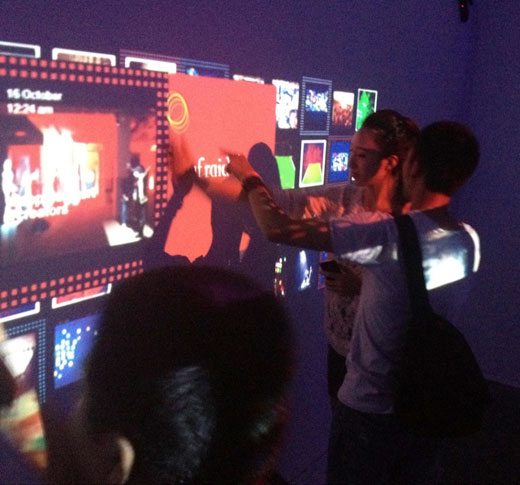Working on much more than your average computer chip, Intel’s Immersive Computing Lab‘s mission is to improve the ways people interact with technology. This team of artists, psychologists, humanfactors engineers, research faculty, and system software architects explore non-intrusive ways in which technology can assist us in everyday life and social exchanges.
During Design Week Portland, you’ll have the chance to interact with these innovators’ work at AIGA Portland’s exhibit, Blurred Lines: A Curated Exploration of the Future of Interaction held October 9-11, 2013 at Refuge PDX.
We asked Intel a few questions about their Blurred Lines installation. This is what they had to say:
What are you creating for Blurred Lines and who is the team working on it?
PIXEE is a highly interactive system that encourages emotional expression in image-based social media. As presented at Blurred Lines, PIXEE is integrated with dual interaction extensions (DIXEE) that allow participants to experience social media with both touch and full body interactions.
PIXEE and DIXEE emphasizes the social aspect of social media. It integrates Instagram, Twitter, and participant self-expression into a cohesive system that blurs the lines between the “physical” and the “virtual” worlds, using socially engaging experiences with “connected” day-to-day objects that travel the entire Refuge space.
Our team is: Kymberly Brown, Douglas Carmean, Cindy Chung, Nico Galoppo, Adam Laskowitz, Debbie Marr, Carl S. Marshall, Margaret Morris, Selvakumar Panneer, MorganX D Sutherland, Dalila Szostak, Janet Tseng, and Kathy Yuen.
What is the inspiration behind it?
We are inspired by the immersiveness of “display anywhere” and the social aspect of social media. How can we bring those together to blur the lines between people, and between people and technology?
Tell us about your creative process?
We put a whole bunch of things in a blender without the top on, hold cups upside down to catch the blender spitting things out, drink/eat it, and see what comes out.
Sounds delicious! Have you found a food card in town that serves that?
No, but Mississippi Market Place and Wolf & Bears for the best falafel in town.
Oh man, now I’m really hungry. Say, what do you think Abraham Lincoln would say if he saw your installation? What would his reaction would be?
What the hell is a computer? He would burn us for witchcraft.

Copyright Intel
What excites you about the creative scene in Portland?
Unlike the major metropolitan centers where space is expensive and reputation is more important, people have time and space to explore ideas that may not be immediately appealing or monetizable. Additionally, there is an incredible amount of tech research, development, and know-how present in the area. All of this makes Portland ideally situated to see the emergence of new synergies between design, art, and technology.
There’s a quote from Deb Hiller on her artwork somewhere in town: “Portlanders continuously find the beauty in what is often perceived as ugly.” This is what is interesting about our creative scene.
Well, that and Fred and Carrie…Say, who would play you in an episode of Portlandia?
Our boss is a bit like Kyle MacLachlan.
Nice. Do you think humans will someday have the option to spend their entire life in an alternate reality? Would you?
People already do this – see World of Warcraft, Everquest, EVE Online. I am not currently doing this because I was raised in an environment where I was taught to value nature, society, my body, and intimate connection with other people. To give up on this would be to totally transform my identity. However, increasingly we will be able to simulate aspects of our world using computing simulations and mass communication technology. Already people participate in rich audio-visual environments, build micro-societies with their own politics, war, economics, etc., and fall in love with comrades. The only thing that is not currently well simulated is the body’s relationship with the environment. We already know that sitting in a chair, no matter how ergonomic, will kill you. Especially if we can learn to meet the pleasures and needs of the body in immersive interfaces, I have no doubt that even more people will choose to devote their lives to virtual worlds.
Whether or not this is a good thing is a much larger topic that I haven’t sorted out yet, though I’m definitely biased toward thinking that it is not.

Copyright Intel
What is design?
“Design” is an incredibly vague and over-used word, a bit like “sustainability.” For us, design is rational decision making and action. A desired outcome is identified (value), a plan to realize that outcome is devised, and the plan is carried out. In other words, design is thinking about what to do and then thinking about it as you’re doing it. But then, this is almost the same thing as being a philosopher. And there are many more specific definitions of design depending on the context.
What is good design?
More than anything else, having enough time, resources, and freedom to fully explore a problem. Ditto for designers – designers need enough time, resources, and freedom to educate themselves, hone skills develop a coherent vision for the future to guide their work. Most things and people suffer from being rushed.
Well said.
A big thanks to Intel for rethinking computing and going where no man has gone before. I’m looking forward to seeing what it’s like when PIXEE and DIXEE blurs the lines between the physical and the virtual at Blurred Lines in just a few days.
You too can experience Intel’s PIXEE and DIXEE October 9-11th at Blurred Lines: A Curated Exploration of the Future of Interaction – where leading design studios in Portland share their experiences of what can (and may) happen when light, sound, images, motion, culture and history combine. Explore a space like you’ve never imagined, grab a drink at the bar and groove on music spun by different DJ’s each night.
Buy your tickets now at: http://blurredlines.eventbrite.com/